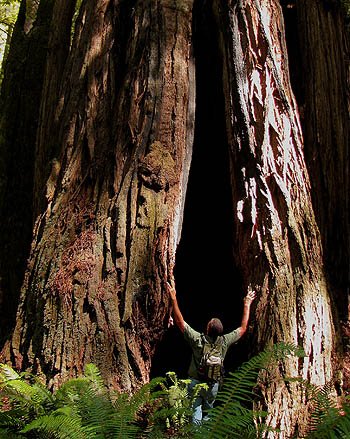
What is a Redwood Goosepen ?
Continued from: Coast Redwoods

advertisement
Copyright 2010 - 2013 by Mario Vaden
Goosepens are openings or hollow areas in coast redwood trunks, typically caused by damage, decay and forest fire.

Years ago, some early settlers to the redwood coast area could keep geese or other fowl in these openings.
These wooden caves were large enough for bigger animals to be kept in too: even horses or goats.
In the redwood parks, the hollow openings may make a good shelter for black bears also.
There are several types of damage that can start this process. A redwood's own top canopy can break and chunks weight tons can rip bark from the lower trunk.
Other redwoods, spruce, hemlock or Douglas fir can fall over and damage the trunk too.
One other way is when redwoods have multiple vertical trunks against each other, then one falls away leaving what some folks call a "wound".
The damaged area slowly dies and decays. One or more forest fires will ignite the exposed dead heartwood, causing it to burn or smolder.
These large hollow cavities may be the result of one or several forest fires. One redwood that may have been hollowed by several fires is the Church Redwood up ChurchTree Rd. near the edge of Crescent City. I am posting about it tonight in my redwood blog after editing this page.
If a redwood or other conifers deposit enough limb debris around a trunk, forest fires may burn hot and long enough next to a trunk to burn through healthy bark and cause a wound. Then a future fire may start to hollow-out an opening there. Because wet wood does not ignite, a fire around a complete healthy trunk would not cause a goosepen. It would take another forest fire, or lightning strike to trigger the process.
Redwoods can still live with these hollow caves at the base, because the only living tissue in the trunk is a thin layer of tissue beneath the bark called the cambium. As long as the trunk maintains enough other wood tissue to keep it standing and move water and nutrients up to the needles, the redwood can stand for centuries.
Some are more exposed looking like the photo shown. Others have shorter openings but may be the size of rooms inside. I photographed one in Prairie Creek once near the visitor center, that was about 18 feet wide inside. About 2 weeks before posting this page, we found one in Jedediah Smith redwoods that had about 150 square feet of floor space, with two small "windows" for light. We called that redwood Caveman.
Don McLellan, the Goosepen Hermit
Have you heard the story about Don Mc Lellen?
The story is that he arrived in Humboldt County around 1958 to 1959, and resided in a redwood goosepen. The inside was large enough for a wood stove, shelves, utensils and supples. Using various redwood beams, he constructed a second and third story over the kitchen. There was a straw mattress at the second floor bedroom, and belongings on the third floor. His stove had a curved chimney that diverted smoke through a big crack to the outside.
The story continues that to the southwest was a second goosepen where he stowed ropes, climbing spurs and bicycle. And a third one used as a smokehouse These useful caves in redwoods were enclosed with strong redwood doors and secured with stout padlocks.
Evenlyn McCormick, author of The Bluffs Around Us, described McLellan as a cleancut man who came from the state of Washington, where he worked around pine and Douglas fir forests.

advertisement